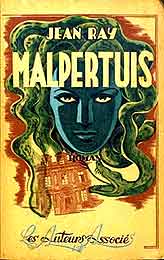By JEAN RAY (Atlas Press; 1943/98)
Although it wasn’t published in English until 1998 (in an edition now sadly out of print), Jean Ray’s MALPERTUIS is one of the great novels of supernatural horror. It’s the endlessly complex, deeply hallucinatory account of the eccentric inhabitants of an accursed mansion known as Malpertuis, who spend their days bickering and playing games—at least when they’re not caught up in inexplicable supernatural phenomena.
Jean Ray’s MALPERTUIS is one of the great novels of supernatural horror.
No less than four distinct narrative strands are utilized in this bizarre account, yet the book never feels cluttered or fragmented. Indeed, upon reaching the final chapters, with their detailed explanation of all that came before, I found it impossible not to marvel at just how streamlined and precise MALPERTUIS (as translated by Iain White) is. Its characters include a doomed mariner terrified by the sight of several giant statues populating a mysterious island; an evil sorcerer with a deeply rooted God complex; an unfortunate young man shut up with several distant relatives in the gloomy confines of Malpertuis, where he finds himself torn between two insatiable women; and a studious monk, who binds all these plot strands together.
Spoilers ahead!
(A Word to the Wise: those wanting the “full effect” of MALPERTUIS are advised to skip the remainder of this review until after reading the book, as I’ll be revealing some—though certainly not all—of its secrets herein)
As the book progresses it gradually becomes clear that the inhabitants of Malpertuis are in fact the gods of Ancient Greece sewn into human skin, given assumed names and plopped down in the accursed house by their “Uncle” Cassave, actually a centuries-old practitioner of black magic. Zeus, the king of the gods, is there, in addition to Apollo, Prometheus (who was sentenced to have his guts ripped out repeatedly by a ravenous eagle, an act detailed in MALPERTUIS), Vulcan (who spit fire) and even Medusa, the gorgon whose gaze was capable of turning people to stone (an action that likewise turns up here). It seems that as people stopped believing in them the Gods lost their powers, leaving the opportunistic Cassave with a perfect opportunity to step in and snatch ‘em up for his own nefarious purposes.
No less than four distinct narrative strands are utilized in this bizarre account, yet the book never feels cluttered or fragmented… Required reading, period.
Jean Ray (1887-1964) was a famed Belgian fantasist whose horrific/fantastic tales remain among the most powerful and distinctive on the scene, even if they’re little known in the English world (his only other English language works are the collections GHOULS IN MY GRAVE and MY OWN PRIVATE SPECTRES, both highly sought-after collector’s items among horror connoisseurs). MALPERTUIS was his only novel-length work and is generally considered his masterpiece. It’s certainly one of the most unusual horror novels you’ll encounter anywhere, with its frankly surreal prose that often reads like a Salvador Dali painting come to life. MALPERTUIS’ English publisher was Atlas Press, known for publishing “anti-classics” by the likes of Andre Breton, Luis Aragon and Raymond Roussel, authors whose works make for good company with the present book.
Another author MALPERTUIS directly recalls is H.P. Lovecraft, of whom Jean Ray was a longtime admirer, although in truth Ray’s work is far too tricky and distinctive to be mistaken for that of anyone else. The book’s dreamlike air is offset by curiously logical, meticulous prose that manages to establish a deceptive air of normalcy and routine amidst the inhabitants of Malpertuis, which makes the supernatural interludes seem all the more startling. The book’s overriding conceit is an admittedly outrageous one, but the unshakable conviction and audacity of the author’s imagination, as well as his near-obsessive attention to the tiniest details (it’s no surprise the book reportedly took “ten years, perhaps twelve” to complete) make for a compelling gothic fantasy that Ray manages to complete in a brisk yet satisfying 172 pages. Required reading, period.

